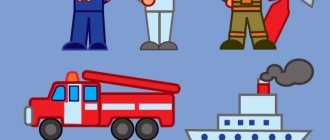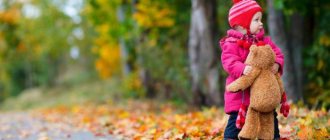A detailed and complete presentation of the content and course of the logorhythmic lesson is presented, reflecting the joint activities of the teacher and preschoolers. Phrases from a speech therapist, speech material and descriptions of children’s actions are included. The proposed lesson notes are recommended to be used for joint activities with people with speech disorders, as well as with autism (ASD).
Theme of the logorhythmic lesson: “In the autumn forest”
Non-speech goals:
- development of coordination of movements, orientation in space;
- development of auditory perception, attention, memory;
- developing the ability to work in a team of peers;
- development of a sense of rhythm and ear for music;
- development of creative thinking;
- normalization of muscle tone.
Speech goals:
- development of speech breathing and voice formation;
- development of facial and articulatory motor skills;
- synchronization of speech with movement;
- development of prosodic components;
- activation of the dictionary on lexical topics “Autumn”, “Forest”, “Trees”, “Wild Animals”.
Equipment: plot painting “Autumn Forest”; toy trees; dummies of mushrooms (or object pictures); fairy-tale characters - hedgehog, bear; wooden spoons, rattles, technical means for playing music.
Preparatory group. Senior preschool age. Children 6-7 years old
Logorhythmic lesson “What do you have?” for children 6–7 years old Goal: overcoming speech disorders in children through the development and correction of the motor sphere in combination with words, music and movement as part of early career guidance. Objectives: - Systematize children’s knowledge about professions; -Consolidate the acquired knowledge on the material of the poem S....
Speech therapy entertainment based on traffic rules with elements of logorhythmics for children 6–7 years old with TNR “Travel by bus” Speech therapy entertainment with elements of logorhythmics for children 6–7 years old with TNR “Travel by Bus”
Goal: formation of all components of speech through
logorhythmic exercises . Objectives: 1.Develop auditory attention, sense of rhyme, visual memory. 2.Develop your hearing...
Summary of a lesson on logorhythmics in the preparatory group Topic: “In search of treasures”
Summary of a lesson on logorhythmics in the preparatory group
Topic: “Treasure Hunt”
Goal: to develop speech and motor abilities in combination with music.
Tasks
Educational:
Learn to perform movements to music at a given tempo
Form motor skills and abilities.
To introduce the variety of movements and the spatial organization of the body.
To form ideas about animals of hot countries, birds, and marine life.
Correctional and developmental:
Develop auditory attention and memory. Develop speech skills, teach children to clearly pronounce simple words, improving the ability to hold their breath until the end of the phrase. Develop a sense of rhythm, correctly perform a rhythmic pattern in combination with music. Develop facial expressions, muscle tone, imagination, fantasy.
Develop fine muscles of the fingers. Develop general motor skills and plasticity.
Educational:
Promote mental, moral, aesthetic, creative activity.
Foster a sense of collectivism, initiative, and strong-willed spirit.
Foster self-regulation in actions, behavior, and communication.
Equipment: soft toy giraffe, palm tree, footprints of a small and large elephant, cut out of linoleum or cardboard, key, chest, fruit, stencils of animals from hot countries.
Multimedia projector, screen: image (elements) of a map, image of the seabed and sea animals, riddle pictures.
Lesson plan:
Introductory part: 5 minutes
Main part: 15 minutes
Final part: 5 minutes 1. Introductory part
Purpose: greet the children, announce the topic of the lesson, conduct a rhythmic warm-up in the form of a water exercise.
V.: - Children, this morning a strange message came to our computer. The recipient line says: “treasure seekers.” Do you and I love adventure? Let's look for treasure? Then this letter is for us. Let's see what the letter contains. (An element of an ancient map appears on the screen.) -What is this? -Do you think that from such a piece of the map you can determine where the treasures are? -Let's read what the message says (reads) “This is a treasure map. It will open completely for those who can solve all the riddles and overcome the difficulties that you will encounter along the way.” V.: - We are not afraid of difficulties and set out on the road! Really guys? (yes) V.: -Here’s a warm-up task for you. Listen and guess what you and I will take on our journey. (Children hear the whistle of a steamship, sometimes far away, sometimes close. If the children name correctly, then a steamship appears on the screen.) *Exercise “Steamboat”
Goal: develop a sense of rhythm: walking to music; voice strength: quiet, loud, with increasing sound, with attenuation. (Chorus “The steamer is humming”, music by T. Lomova, lyrics by A. Gangov)
The children walk one after another to the music around the hall like a snake and, together with the teacher, sing the words: People are waving from the pier The steamer gives a signal (Then they stop and loudly say ooh-oh) The steamboat is already sailing away And our signal fades away.
(Stop and quietly say ooooh) 2. Main part.
Goal: to develop vocal strength, facial muscles, fine and gross motor skills, auditory attention and memory, sense of rhythm, speech skills, coordination of movements, music and speech
V.: - So we set off on a long journey, and a cheerful breeze will help us get to the shore faster. *Zheleznovs’ logorhythmic exercise “Wind”
Goal: to promote the development of voice strength, fine and gross motor skills, coordination of hand movements and speech.
V.: - And here is the first task (An image of the seabed with sea animals appears on the screen. Task “Name and show the sea inhabitants”)
* Finger gymnastics “Sea inhabitants”
Purpose: to develop fine motor skills
(children use their fingers to depict a fish, jellyfish, crab, starfish) (Another card element appears on the screen)
V.: - Guys, look at our map. Another element appeared on it. This means we did everything correctly. The melody to the song “Sailors” sounds (lyrics and music by M. Shokhin)
V.: - Guys, this is the music for the next task. (Reads the inscription on the screen “Guess what kind of song this is”) The guys guess and perform the song “Sailors” (lyrics and music by M. Shokhin) (Another map element appears on the screen) The sound of the sea sounds (Appendix No. 3) * Exercise "Waves"
Goal: to develop voice strength, exhalation duration
V.: - And here you can see the shore, and what waves! The waves roll onto the shore, rustling pebbles: Sh-sh-sh (children pronounce for a long time) And now the waves roll onto the sand sh-sh-sh (children pronounce more quietly and briefly)
V.: -So we came to Africa. *Exercise “Sun”
Purpose: to promote the development of facial muscles
V.: -And what a hot, bright sun it is in Africa. A bright sunbeam hit the right eye (close the right eye), hit the left eye (close the left eye), and hit both eyes (close both eyes). They lowered their heads. We want to look at the bright sun again. Let's raise our heads again, squint, then close our eyes, lower our heads again.
V.: -And here is the next task (reads the inscription on the screen “Guess the riddles. For each correct answer, another piece of the card will be revealed to you”) Riddle about the elephant:
He has big ears The longest nose in the world He is the largest on land Who is he? Here's a question for you? Children guess, and a picture of an elephant appears on the screen) *Exercise “Elephant and Baby Elephant”
Goal: develop auditory attention, sense of rhythm
V.: -And now the elephant and his baby elephant also want to play with you. The children sit in a circle. The music director taps a certain rhythm, and the children lay out the tracks of a large elephant and a small elephant. (Another piece of the map appears on the screen.) V.: - Next riddle:
Motley fidget Long-tailed bird Talkative bird The most talkative (For the correct answer, a picture of a parrot appears on the screen) *Exercise “Repeat after me”
Goal: to develop auditory memory, attention, speech skills, voice power.
V.: - The parrot loves to parrot, that is, to repeat after someone and he will play with us with pleasure. Repeat after me (loudly, in a low voice, quietly) Mu-mu-mu - I’ll quickly raise the sail (claps your hands above your head) Now, now, in Africa there live elephants (turns the body to the right and left) Il-il-il and a toothy crocodile (head tilts to the right and left) Ai-ai-ai - here is a cheerful parrot (fingers crossed, rhythmically raising and lowering fingers.) From-from-from and a huge hippopotamus (fingers spread out, palms facing each other - depicts opening and closing mouth of a hippopotamus) Lu-lu-lu - I love to travel (claps your hands in front of you) Ti-ti-ti - it’s time for us to go further (walking in place) (Another piece of the map appears on the screen.) V.: - The riddle is as follows: What kind of mischief is this, having fun on a vine, swinging on its tail, jumping and making faces. (For a correct answer, a picture of a monkey appears on the screen)
V.: -The monkeys want to play with us. *Exercise “Monkeys”
Goal: learn to coordinate hand movements and speech, develop gross and fine motor skills.
Two naughty monkeys (Put out their ears) Loved to look through books (cling and unhooking with fingers) Shake them (Shake off fingertips) Lick (Exercise delicious jam) And as if reading (we move the index finger of our right hand) Deftly set to work (connect the index finger with the thumb ) And they put on the glasses (Show the glasses with your fingers) They brought the book to your nose (Bring your palms to your nose) Suddenly they took you further away (Move your palms away from your face) Nothing is visible in the glasses (Close your eyes and face with your palms) And the monkeys are so offended! ("Collect tears "in a cup) (The last element of the card appears on the screen.) 3. Final part
Purpose: to summarize, evaluate the activities of children; promote muscle relaxation and relieve emotional stress.
V.: - Guys, look, the map is ready! Look at the map, where should we look for treasure? (Children find the location of the chest under the palm tree on the map and approach it)
V.: -Look, the chest is guarded by a giraffe. Let us cheer him up, maybe then he will give us the key to the chest. *Zheleznovs’ logorhythmic exercise “The giraffe has spots and spots”
Goal: to develop coordination of words and movements with musical accompaniment. Self-massage.
Children open the chest and find fruits and stencils of African animals in it (for outlining and shading)
V.: -Fruits can be called a treasure, because they contain many different vitamins and lift your spirits. And you will take the stencils home, trace them, color them and remember our amazing journey. Q: Guys, what did you find particularly interesting? Difficult? Funny? What worked best? (children's answers)
V.: -And it’s time for us to return to kindergarten, let’s imagine, sitting on chairs, that we are walking, and then running to kindergarten.
Relaxation exercise: “Walk”
Goal: promote muscle relaxation and relieve emotional stress.
Children sit on chairs. Muscle tension = walking, running with elevated legs without touching the floor.
Next, the legs stand, arms hang down, relaxation.
V.: - Guys, here we are back in kindergarten. Thanks to all!
Bibliography. 1. Gogoleva M.Yu. Logorhythmics in kindergarten. Senior and preparatory groups, Yaroslavl, Academy of Development, 2006 2. Alyabyeva E.A. Logorhythmic exercises without musical accompaniment, Moscow, Creative Center, 2006
Logorhythmics. Logorhythmic activities - Logori for children of middle and senior preschool age
Publication “Logori for middle and senior preschool children...” Logorhythmic lesson on the lexical topic “Sea”. We greet each other with Zoeysova. Zoya the Owl suggests going on a sea voyage today and reminds the children that the sea can be different, for example, for me the sea is • my favorite, salty and alive; And if the sea is alive, it means...
Logorhythmics lesson in the preparatory speech therapy group “Journey to the spring forest” Goal: Overcoming speech disorders through the development and coordination of the motor sphere. Objectives: 1.Health: - development of breathing - formation of correct posture. 2. Educational: - to form motor skills and abilities; - develop spatial concepts; -...
Logorhythmic exercises as a means of enriching the vocabulary of older preschool children with special needs Author: Daria Belyunova In the federal state educational standard for preschool education (FSES DO), speech development is highlighted as one of the main areas of development and education of preschool children. It includes: mastery of speech as a means...
Logori (middle and senior preschool age) “Teremok” There is a teremok in a field (join your palms in a “house” (gesture “house”) It is not low, not high. Like a mouse running across a field (the index and middle finger of the hand run along the left palm ( “mouse” gesture) Stopped at the door and knocked: “Who? Who lives in the little house? (we knock with our right fist...



